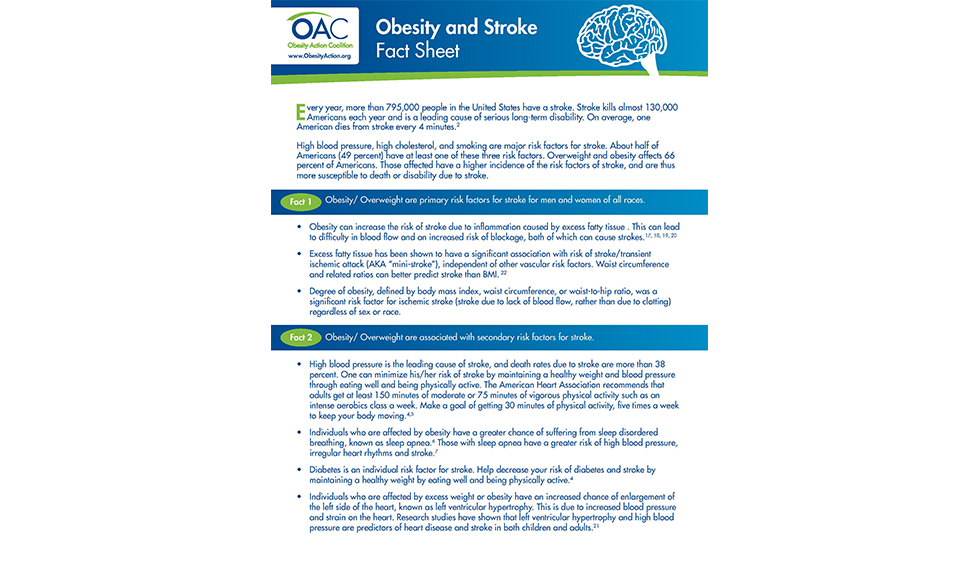Obesity and Stroke Fact Sheet

Every year, more than 795,000 people in the United States have a stroke. Stroke kills almost 130,000 Americans each year and is a leading cause of serious long-term disability. On average, one American dies from stroke every 4 minutes
High blood pressure, high cholesterol, and smoking are major risk factors for stroke. About half of Americans (49 percent) have at least one of these three risk factors. Overweight and obesity affects 66 percent of Americans. Those affected have a higher incidence of the risk factors of stroke, and are thus more susceptible to death or disability due to stroke.
Obesity/ Overweight are primary risk factors for stroke for men and women of all races.
- Obesity can increase the risk of stroke due to inflammation caused by excess fatty tissue . This can lead to difficulty in blood flow and an increased risk of blockage, both of which can cause strokes.
- Excess fatty tissue has been shown to have a significant association with risk of stroke/transient ischemic attack (AKA “mini-stroke”), independent of other vascular risk factors. Waist circumference and related ratios can better predict stroke than body mass index (BMI).
- Degree of obesity, defined by body mass index, waist circumference, or waist-to-hip ratio, is a significant risk factor for ischemic stroke (stroke due to lack of blood flow, rather than due to clotting) regardless of sex or race.
Obesity/ Overweight are associated with secondary risk factors for stroke.
- High blood pressure is the leading cause of stroke, and death rates due to stroke are more than 38 percent. One can minimize his/her risk of stroke by maintaining a healthy weight and blood pressure through eating well and being physically active. The American Heart Association recommends that adults get at least 150 minutes of moderate or 75 minutes of vigorous physical activity such as an intense aerobics class a week. Make a goal of getting 30 minutes of physical activity, five times a week to keep your body moving.
- Individuals who are affected by obesity have a greater chance of suffering from sleep disordered breathing, known as sleep apnea.6 Those with sleep apnea have a greater risk of high blood pressure, irregular heart rhythms and stroke.
- Diabetes is an individual risk factor for stroke. Help decrease your risk of diabetes and stroke by maintaining a healthy weight by eating well and being physically active.
- Individuals who are affected by excess weight or obesity have an increased chance of enlargement of the left side of the heart, known as left ventricular hypertrophy. This is due to increased blood pressure and strain on the heart. Research studies have shown that left ventricular hypertrophy and high blood pressure are predictors of heart disease and stroke in both children and adults.
- One out of every five individuals who are affected by excess weight or obesity is affected by a metabolic condition known as “Syndrome X.” The factors that characterize this condition, such as high blood pressure or insulin resistance, can increase the individual’s risk for developing more serious health problems including heart disease, diabetes and stroke.
Weight-loss can minimize one’s risk of stroke.
- One way to help prevent having a stroke is by maintaining a healthy body mass index (BMI) and waist-to-hip ratio (WHR). WHR is the measure of your waist (abdomen) in inches compared to the measure of your hips in inches. For both men and women, a waist-to-hip ratio of 1.0 or higher is considered “at risk” or in the danger zone for undesirable health consequences such as heart disease and stroke. By keeping the range of these numbers low, you can help to lower your risk of stroke.
- Research studies have shown that obesity is one of the risk factors that can be changed in order to help decrease your risk of having a stroke.
Healthy lifestyle modifications can decrease stroke risk in adults and children.
- Two of the best ways to lower your risk of stroke are by eating a heart healthy diet with plenty of fruits and vegetables, eating sensible portions and being physically active on a regular basis.
- Help to decrease your child’s future risk of stroke and other chronic conditions by helping them maintain a healthy weight with a heart healthy diet and daily physical activity (The American Heart Association recommends at least 60 minutes a day for kids).
by Sarah Muntel, RD Summer 2024 Here comes summer with sunshine, relaxation and lots of fun! As…
Read Articleby Nina Crowley, PhD, RD Summer 2024 Before we talk about body composition, it’s important to know…
Read Articleby Greer Raggio, PhD, MPH Summer 2024 When we think about grief, we often imagine someone coping…
Read Article







